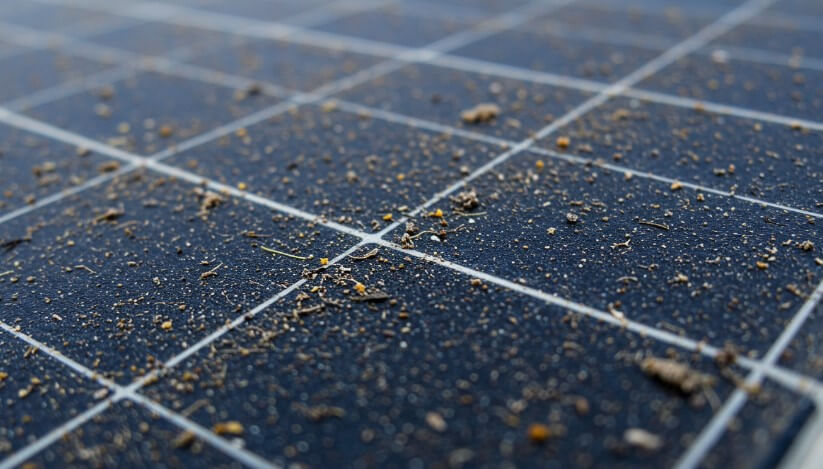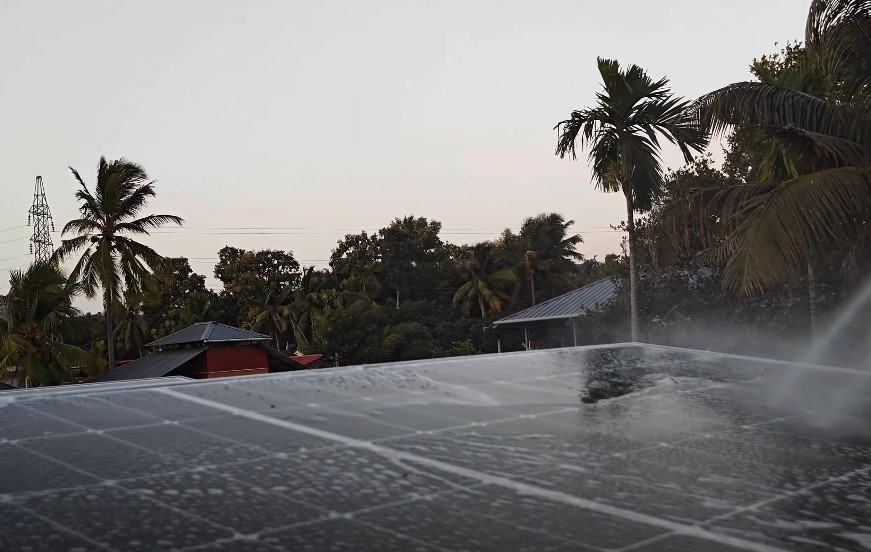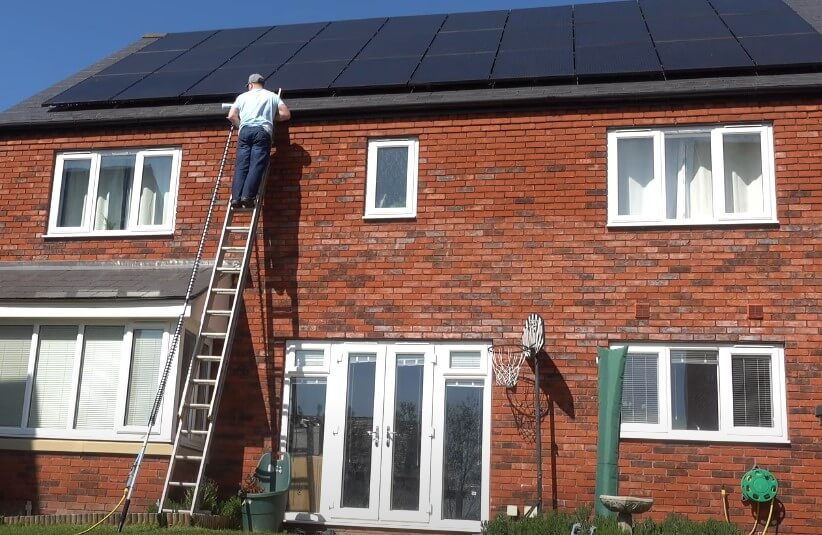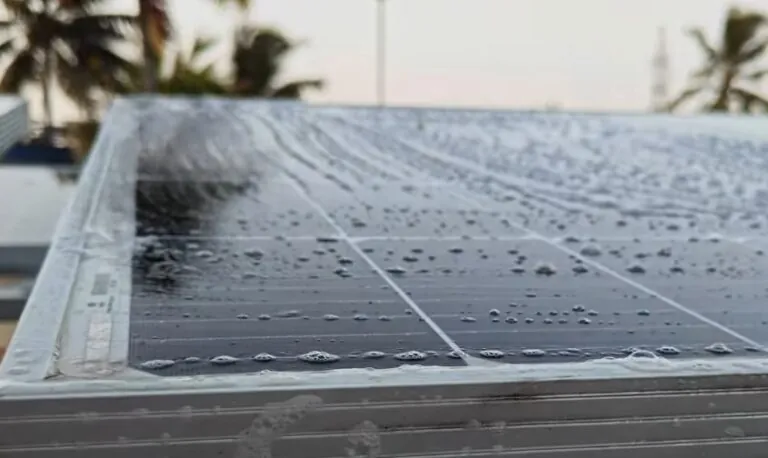Solar power is one of the smartest ways to reduce your carbon footprint, lower your energy bills, and even increase your property’s value. That’s all great news—unless your solar panels are underperforming because of a simple layer of grime.
It’s surprisingly common for homeowners and businesses to go years without cleaning their panels, assuming nature (or rain) will take care of it. But here’s the reality: a layer of dust or pollen may not look like much, but it can dramatically reduce your energy output and slowly drain the returns you were counting on.
We’re not talking about marginal differences, either. Some panels can lose up to 30% of their efficiency in just one month when dirt builds up unchecked. Over time, that’s real money left on the table, and power you’re not getting from the sun.
Let’s walk through why clean panels matter more than most people think, how much it could be costing you, and what you can do about it without risking a slip off the roof.
Dirt Is the Silent Energy Thief

Solar panels are built to last. They’re tough, weather-resistant, and engineered to work for decades. But no panel can perform well if sunlight can’t reach the photovoltaic cells underneath.
Anything that settles on the surface—dust, bird droppings, pollen, ash, leaves, even a light haze from nearby traffic—creates a barrier between the sun and your system.
Here’s what that can look like in real terms:
| Impact of Soiling | Details |
| Efficiency Loss | Up to 30% in one month; ~4.4% annually; over 20% daily during dry spells |
| Financial Hit (Large System) | 1% power loss = ~$200,000 lost annually on a 150 MW system |
| Global Losses | Estimated at $3.3 to $5.5 billion a year worldwide |
| Case Example | A sticky haze cut performance by 10%; after cleaning, output jumped 20% |
That 10% jump came from a system located in a rainforest, where rain should have been enough. But not all dirt gets washed away. Sticky grime, like sap or bird waste, doesn’t budge unless you physically remove it.
When Cleaning Makes a Real Difference

There’s no one-size-fits-all rule for how often panels should be cleaned. It depends on where you live, what’s around your home or facility, and the angle of your panels.
Let’s break it down by environment:
Rainy Regions (with angled panels)
- Rain can handle some of the work, especially if your panels are pitched at least five degrees.
- But even in rainy areas, sticky dirt, pollen, and sap can linger for months.
- A University of San Diego study found that rain keeps solar panels operating at ~95% of their capacity, if dust is the only issue.
Dry or Dusty Climates (think Nevada or Arizona)
- Dust is relentless, and rain is rare. Left unchecked, soiling builds up fast.
- Energy loss in these areas can reach up to 7% annually due to dirt.
- Cleaning every 6 months is usually needed, sometimes more often.
Polluted or High-Traffic Zones
- Near highways, airports, or even large farms, airborne particles increase grime buildup.
- Panels may need quarterly cleanings to stay efficient.
Wooded Areas or Near Trees
- Bird droppings, sap, leaves, and even squirrel mischief can interfere with performance.
- Visual inspections and hands-on cleaning make a big difference.
| Environment | Cleaning Needs |
| Rainy (pitched panels) | Possibly once a year; rain helps—but not always enough |
| Dry/Dusty | Twice a year minimum |
| Polluted zones | Quarterly or more, depending on output |
| Near trees | Regular inspection + manual cleanup as needed |
How to Clean Solar Panels Without Messing Things Up
DIY? Only If You’re Cautious
Cleaning your own panels might sound like a Saturday afternoon project—but it’s not always worth the risk. Rooftop panels are hard to reach, and one wrong step can end in injury or broken equipment.
Still thinking about doing it yourself? Keep these tips in mind:
- Use a soft brush or sponge, nothing abrasive.
- Avoid chemicals. Just water, and preferably deionized or distilled to prevent residue.
- Choose an overcast day or early morning to prevent thermal shock from cold water hitting hot glass.
- Turn off your solar system before you begin. Safety first.
Professional Services
Hiring a professional might cost between $150 to $300 for a full system, or $15 to $30 per panel, depending on your location and roof layout. But they bring the gear, experience, and safety equipment you probably don’t have.
Many solar panel warranties remain intact only if panels are maintained properly—so hiring a pro could protect your long-term investment, too.
Bonus: Some leases or solar financing plans include maintenance. Always worth checking the fine print.
For a polished finish and peace of mind, The Gutter Cleaning Co provides before‑and‑after photos of both gutters and solar panels, ensuring you see the results clearly.
Waterless and Innovative Solutions
In areas where water is scarce, cleaning becomes a sustainability challenge. MIT engineers have tackled this with a waterless cleaning method using electrostatic repulsion—essentially shaking the dust off panels without any liquid at all.
While not mainstream yet, this tech holds major potential for large solar farms in arid zones, offering clean panels without using thousands of gallons of precious water.
| Method | Details | Cost & Risk |
| DIY | Soft brush + water; clean on cloudy days | Low cost; higher risk (injury or damage) |
| Professional | Certified cleaners with equipment and know-how | $150–$300 per system |
| Waterless (emerging) | Electrostatic dust removal; ideal for dry regions | Still in development; varies in cost |
Does It Pay Off? Let’s Talk Money
For homeowners with smaller systems, especially in rainy areas, the savings from cleaning might feel minimal. One study cited by Paradise Energy found that a 5 kW system in California’s driest season only gained about $20 in three months from cleaning.
But there’s more to the story.
In dustier regions or on larger systems, even a 7% drop in output adds up fast. For a medium-sized installation, that might be several hundred dollars annually. For utility-scale farms, you’re looking at six-figure losses every year if panels aren’t kept clean.
And let’s not forget what else cleaning gives you: a chance to spot problems early. Cracks, wiring issues, loose mounts—cleaning often reveals hidden damage that could snowball into bigger issues if left unchecked.
Cleaning and the Environment

Here’s the kicker: the solar industry is trying to save the planet, but cleaning panels currently uses 10 billion gallons of water every year worldwide. That’s enough to supply drinking water for two million people.
Kind of a contradiction, right?
Waterless systems like the one developed at MIT could solve that tension. By removing dust with zero water, they reduce the environmental footprint of solar maintenance and make panel upkeep more sustainable in the long run.
Clean panels also help maximize the green energy you’re producing. Less dirt means more electricity, fewer fossil fuels, and a cleaner grid. In short, regular cleaning plays a small but important role in climate progress.
Don’t Let Dirt Steal Your Sun
Solar panels work hard every day, but they can’t do their job if they’re buried under dust, sap, or bird leftovers.
Whether you’re powering your home, your business, or an entire farm, a clean panel is an efficient panel. The numbers don’t lie—just a little grime can cut your output by double digits. And once that energy’s lost, it’s gone.
So if you’ve been putting off a cleaning because you assumed the rain was enough or the panels still look fine from the driveway, it might be time to rethink. Whether you hose them off yourself (safely), call a pro, or keep an eye on emerging tech, keeping panels clean isn’t just about looks—it’s about protecting your investment and doing right by the planet. It’s like maintaining a garden.
Don’t let a layer of dust rob you of clean energy.
Related Posts:
- Why Light and Intuitive UX Matters More Than Ever…
- 8 Destinations Where Luxury May Be More Affordable…
- 7 Hobbies for Sports Fans Who Want More Than Just…
- What to Improve First in Your Business if You Want…
- Preparing for Baby’s Arrival - What You Need vs.…
- Who Was Dennis Tissington? More About Circumstances…
















